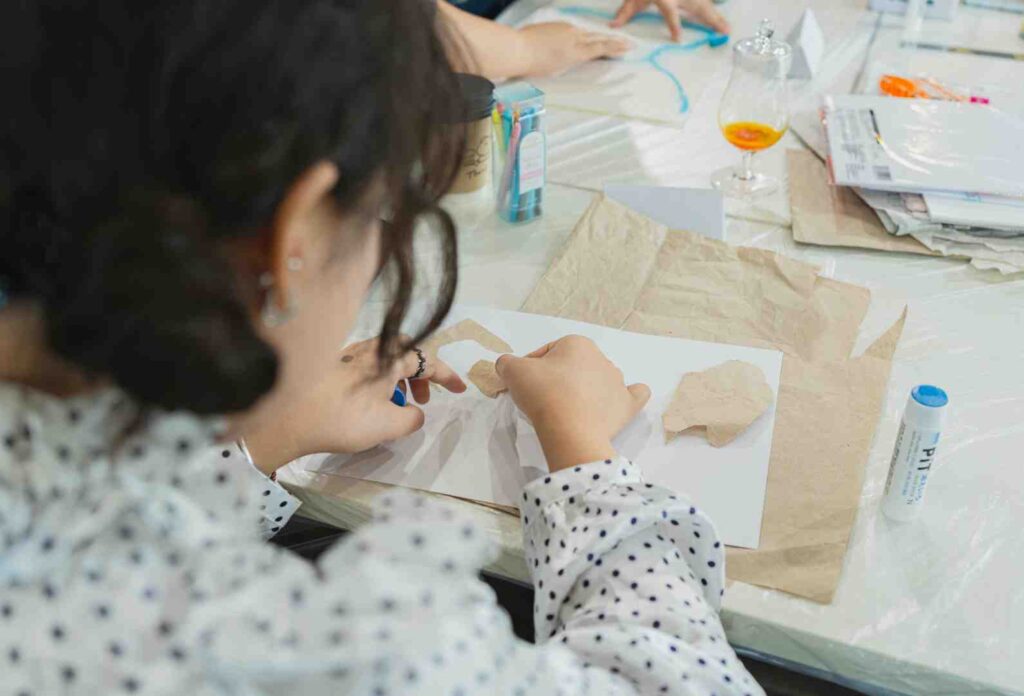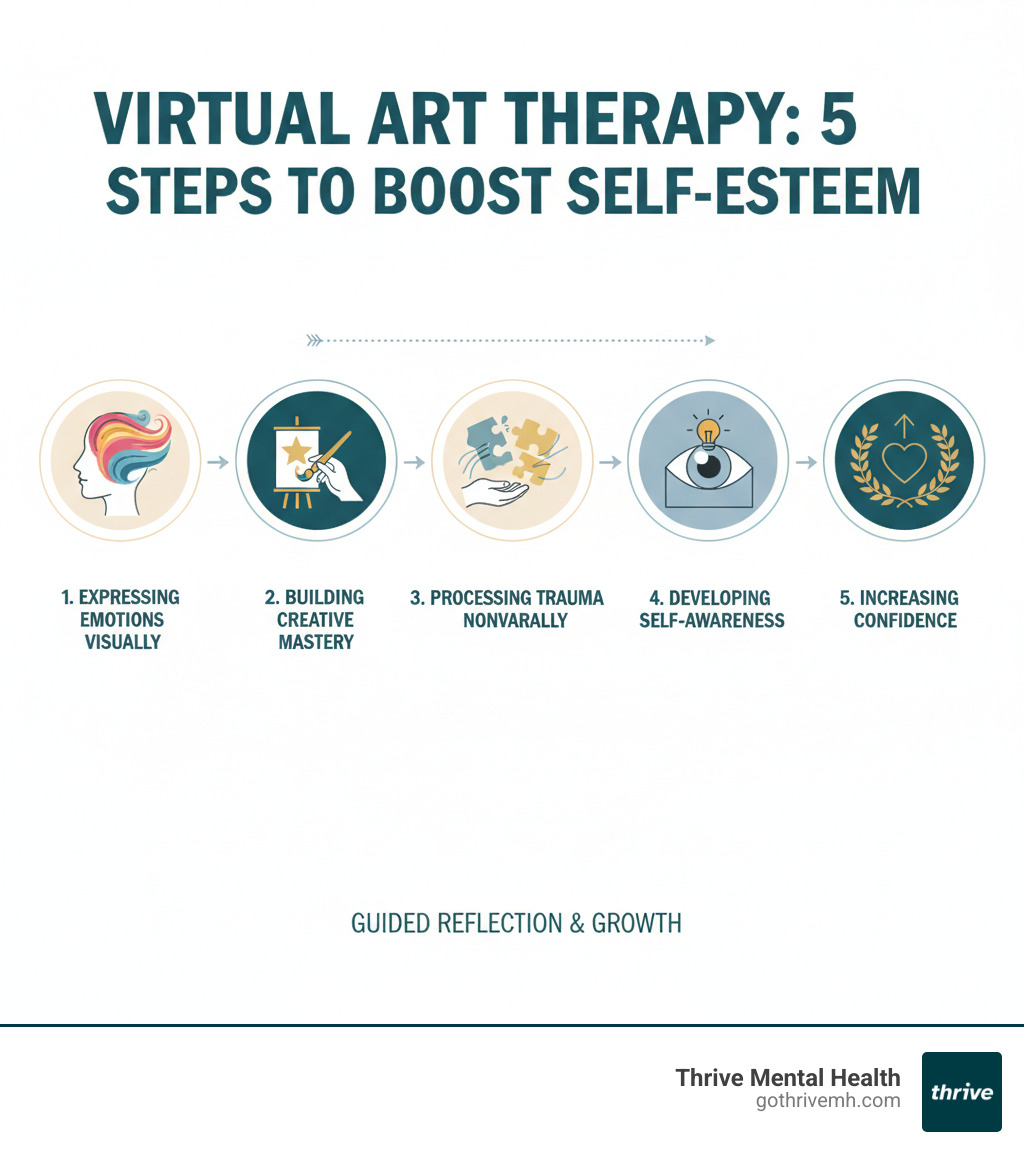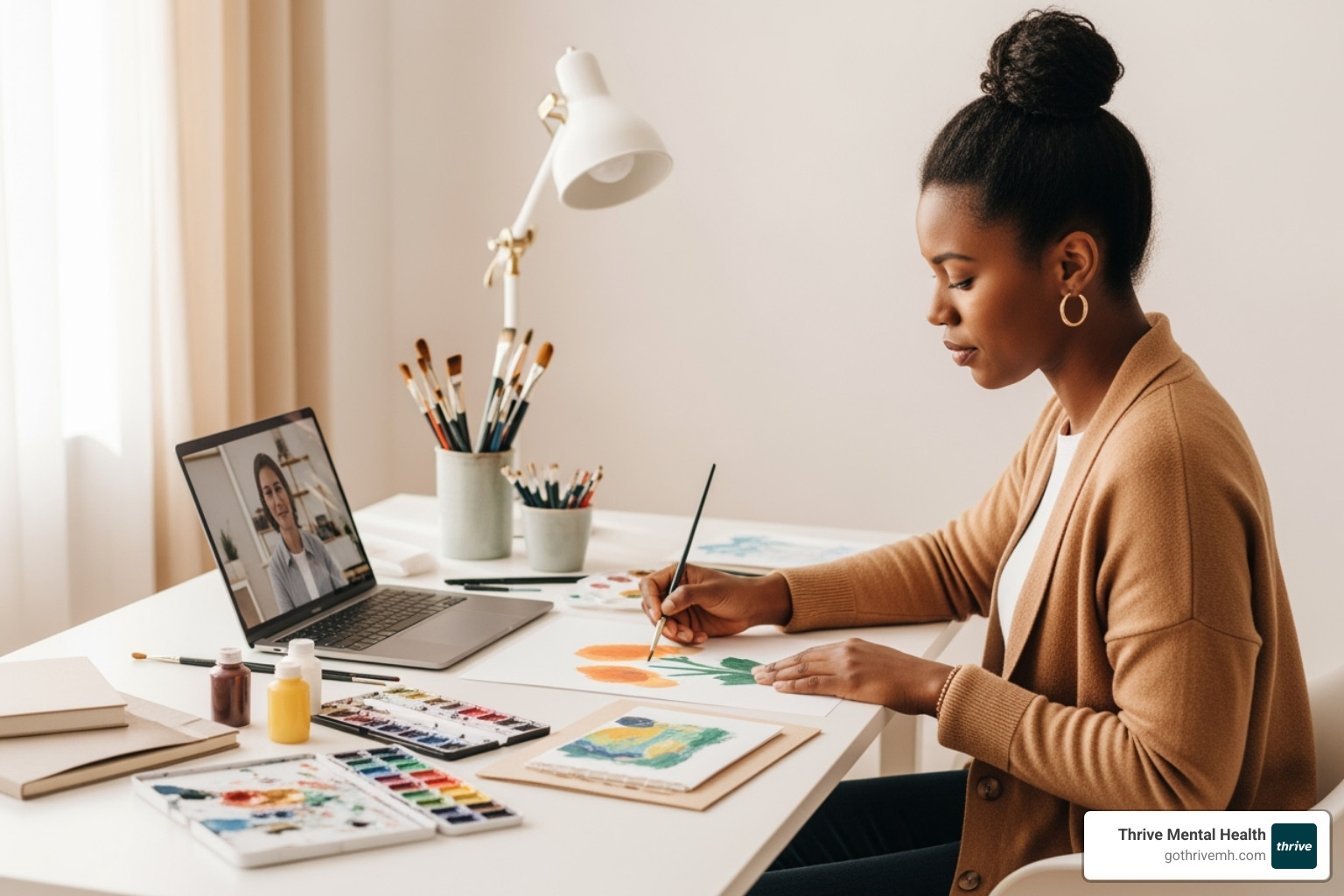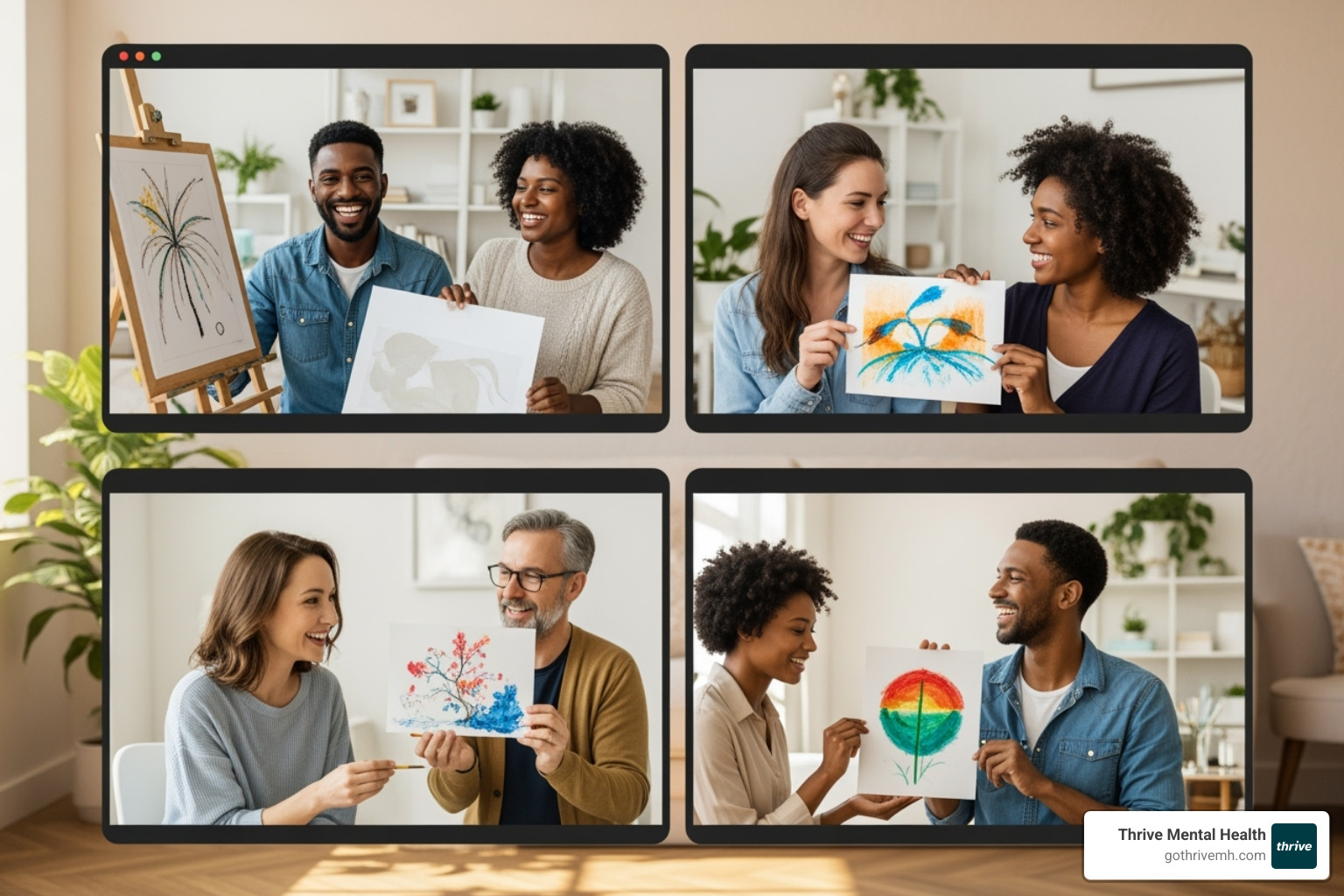The 5 Best Virtual Art Therapy Providers Compared

5 Best Virtual Art Therapy Providers for Self-Esteem
Stop Feeling Worthless: 5 Virtual Art Therapy Options That Actually Build Confidence [2025 Costs Inside]
If you’ve been struggling to articulate how you feel, or if traditional talk therapy hasn’t clicked, virtual art therapy offers a different path. It’s a hands-on, visual, and deeply personal way to build confidence and emotional resilience—all from the comfort of your own home.
Research confirms its power. A review of over 15 clinical studies found that art therapy has “statistically significant positive effects” on mental health and self-esteem. When you create something with your hands, you externalize feelings that are hard to name, build a sense of mastery, and begin to see yourself differently.
Virtual art therapy removes common barriers like travel time and waiting rooms. It provides a safe, judgment-free space with a trained therapist to guide you. At Thrive Mental Health, we integrate art therapy into our evidence-based treatment programs to make healing more accessible, flexible, and effective.

How Virtual Art Therapy Lifts Your Confidence
Sometimes the hardest feelings to talk about are the ones that need healing most. Art therapy offers a path that doesn’t require you to have all the right words. Instead, you express yourself through color, shape, and image from a space where you feel safe and comfortable.
- Accessible from Anywhere: No commute, no waiting room anxiety. You can log in from your couch, kitchen table, or wherever feels private and secure.
- Simple Setup: You don’t need an art studio. Basic supplies like paper, pens, markers, or whatever you have on hand are enough. All you need is a private area and a device with a camera.
- Gentle Guidance: Your therapist isn’t an art critic. Their role is to provide a judgment-free space for you to explore feelings that might be too tangled for words. They help you find your own meaning in what you create.
- Secure and Private: We understand the challenges of virtual sessions. We use secure, HIPAA-compliant platforms and provide clear tech support to ensure your experience is as confidential and therapeutic as an in-person session.
To see the full range of creative approaches we use, learn more about therapeutic art activities.
What Happens in Your First Session?
Your first session is designed to be gentle and exploratory. It begins with a conversation where you and your therapist discuss your goals and preferences. Then, you’ll engage in a simple, no-pressure introductory art activity, like drawing how you’re feeling or choosing colors to represent different emotions. The primary goal is to build a foundation of trust and help you feel safe and understood.
Art Therapy Exercises That Build Self-Esteem
Art therapy gives form to feelings you might not have words for yet. Here are a few powerful exercises used to help you see yourself differently:
- Self-Portraits: Explore how you perceive yourself, both physically and emotionally. It’s not about a perfect likeness but about expressing your inner self-image.
- Drawing Your Strengths: Visualize your positive qualities—kindness, resilience, creativity. Seeing them on paper reinforces that they’re real.
- The “Tree of Life”: Map your roots (past), trunk (present strengths), and branches (future goals) to see your whole story of growth and resilience.
- Creating a Visual “Safe Space”: Design a sanctuary—real or imagined—where you feel secure. This helps you cultivate inner peace and safety.
These exercises, guided by a trained art therapist, help you connect with emotions, gain insight, and build a stronger sense of self-worth. Explore art therapy for low self-esteem to learn more about these techniques.
What Makes a Great Virtual Art Therapist?

Finding the right virtual art therapist is crucial for your healing journey. You need a professional who understands both the creative process and the science of mental health. Here’s what to look for:
- Credentials: A qualified art therapist holds a Master’s degree in art therapy or a related field and is Board Certified (ATR-BC) by the Art Therapy Credentials Board. This certification ensures they have met rigorous national standards for education, experience, and ethics.
- State Licensure: Your therapist must be licensed to provide telehealth services in your state. At Thrive Mental Health, our art therapists are licensed in multiple states, including Indiana, California, Florida, and South Carolina, ensuring compliance with all professional requirements.
- Specialized Training: The best therapists are often trauma-informed and have specific expertise in areas like self-esteem work and adolescent care. This ensures they can tailor activities to your unique needs and life stage.
- Professional Standards: A great therapist adheres to the guidelines of the American Art Therapy Association, which promotes evidence-based practices and the highest ethical standards.
- Insurance Acceptance: Cost should not be a barrier to care. Thrive accepts a wide range of insurance plans, including Cigna, Optum, and Florida Blue, to make treatment more affordable.
The right therapist doesn’t just have impressive credentials—they make you feel heard, understood, and hopeful. They guide without judging and see the potential in you, even when you can’t see it in yourself.
5 Ways to Access Virtual Art Therapy for Self-Esteem
At Thrive Mental Health, we know that one size doesn’t fit all. We’ve designed multiple pathways to access art therapy online, so you can find the right fit for your needs, schedule, and budget.
1. Thrive’s Virtual IOP (Intensive Outpatient Program)

For those who need more than a weekly session, our Virtual IOP provides comprehensive, structured care that integrates art therapy with individual, group, and family therapy. It’s designed to rebuild self-esteem from multiple angles while offering flexible scheduling with evening options to fit your life. More about Thrive’s Virtual IOP with art therapy.
2. Thrive’s Virtual PHP (Partial Hospitalization Program)

Our Virtual PHP offers a higher level of care with daily support and intensive art therapy for those who need significant structure to stabilize and heal. It provides the intensity of hospital-level care from the comfort and privacy of your own home, making it ideal for stepping down from inpatient care or addressing a mental health crisis. Learn about Thrive’s PHP programs.
3. Thrive’s Individual Virtual Art Therapy Sessions
If you prefer personalized, one-on-one care, our individual sessions create a direct, trusting relationship with a licensed art therapist. Your therapist designs each session around your specific needs, guiding you through activities that resonate with your personal journey at a pace that feels right for you. See Thrive’s virtual therapy options.
4. Thrive’s Teen & Young Adult Art Therapy Groups

Adolescence and young adulthood present unique challenges to self-esteem. Our specialized virtual art therapy groups create a safe, teen-focused space for young people to express themselves and connect with peers who understand. The group setting provides powerful peer support, helping participants realize they’re not alone. Art therapy for teens at Thrive.
5. Thrive’s Insurance-Friendly Art Therapy Access
Cost shouldn’t be a barrier to healing. We are in-network with major insurance providers, including Cigna, Optum, and Florida Blue, to make our services affordable. Our team offers easy insurance verification so you know your costs upfront. We serve clients across multiple states, with a strong local presence in Indiana and California. Verify your insurance in 2 minutes.
Costs, Insurance, and Getting Started
Navigating the logistics of mental health care can feel like a major hurdle. At Thrive Mental Health, we prioritize transparency to make getting started as simple as possible, especially for our clients in California (including San Diego, Los Angeles, and Sacramento) and Indiana (Indianapolis and Fort Wayne).
Understanding the Cost
The cost of virtual art therapy depends on the level of care. While out-of-pocket rates for individual sessions can range from $100-$200, most of our clients use their insurance benefits, which significantly reduces this cost to a standard copay. Our more structured Virtual IOP and PHP programs are often covered by insurance as well, making comprehensive care surprisingly affordable.
We are in-network with a wide range of providers, including Cigna, Optum, Florida Blue, and many others. Our team will verify your benefits for you, so you’ll understand your coverage, copay, or deductible before you commit to anything. For those without insurance, we also offer sliding scale fees when appropriate.
How to Get Started in 3 Simple Steps
- Quick Assessment: Complete a brief online or phone assessment so we can understand your needs and goals.
- Insurance Check: We’ll verify your insurance benefits, usually within 24-48 hours, and explain your coverage clearly.
- Get Matched: We’ll connect you with the right licensed art therapist and program for your schedule and clinical needs.
Our virtual platform means you can access expert art therapy from your own safe space, eliminating the stress of commutes and waiting rooms. We’re here to help you find the right path forward for your self-esteem journey.
Frequently Asked Questions About Virtual Art Therapy
Do I need to be good at art for art therapy?
No. Art therapy is about the creative process and self-expression, not the final product. Your therapist is there to guide you, and no artistic talent is required.
What if I don’t have fancy art supplies?
Basic supplies like paper, pens, and markers are all you need to start. Your therapist can adapt activities to whatever materials you have available at home.
Is virtual art therapy effective for teens?
Yes. Many teens and young adults feel more comfortable expressing themselves in a digital environment. Virtual art therapy provides a safe, engaging space for them to explore complex emotions and build confidence. Learn more about art therapy for teens.
Will my insurance cover virtual art therapy?
Many insurance plans cover virtual mental health services, including art therapy. Thrive is in-network with major providers like Cigna, Optum, and Florida Blue. We can help you verify your specific benefits.
How quickly can I start virtual art therapy at Thrive?
Most clients can begin within 48-72 hours after completing our assessment and insurance verification. We offer flexible scheduling including evening options to fit your life.
What if I’m in crisis?
If you are in crisis or need immediate support, please call or text 988 to reach the Suicide & Crisis Lifeline. You are not alone, and help is available 24/7.
Your Next Step: Start Healing with Thrive
Art therapy is a powerful, accessible way to build self-esteem and heal from home. Thrive Mental Health offers flexible, insurance-friendly virtual IOP, PHP, and individual art therapy—serving Indiana, California, and beyond.
Ready for support? Thrive offers virtual and hybrid IOP/PHP with evening options. Verify your insurance in 2 minutes (no obligation) → Start benefits check or call 561-203-6085. If you’re in crisis, call/text 988.
5 Ways to Access Virtual Art Therapy for Self-Esteem
Finding the right path isn’t one-size-fits-all. Thrive integrates art therapy across multiple levels of virtual care so you can choose the structure that matches your goals, time, and budget.
1. Thrive’s Virtual IOP (Intensive Outpatient Program)

Comprehensive weekly structure that blends individual, group, and family therapy—plus art therapy woven throughout. Flexible evening/hybrid scheduling. See details: Thrive’s Virtual IOP with art therapy.
2. Thrive’s Virtual PHP (Partial Hospitalization Program)

Daily, intensive support (from home) with frequent art therapy to stabilize, process, and rebuild self-esteem. Ideal as a step-down from inpatient or when weekly care isn’t enough. Learn more about Thrive’s PHP programs.
3. Thrive’s Individual Virtual Art Therapy Sessions
One-on-one sessions custom to your goals and pace. Build trust, clarity, and confidence through guided creative work. Explore options: Thrive’s virtual therapy.
4. Thrive’s Teen & Young Adult Art Therapy Groups

Teen-focused groups that use art to express, connect, and normalize tough feelings—boosting self-esteem through peer support. Details: art therapy for teens.
5. Thrive’s Insurance-Friendly Art Therapy Access

In-network with major plans (including Cigna, Optum, Florida Blue). Fast benefits check and clear pricing so cost isn’t a barrier. Verify your insurance in 2 minutes.
Costs, Insurance, and Getting Started in California & Indiana
Navigating costs shouldn’t slow you down. Thrive keeps pricing transparent and insurance simple across California (Sacramento, Los Angeles, San Diego) and Indiana (Indianapolis, Fort Wayne).
- Individual virtual art therapy: Often $100–$200 self-pay; many clients pay an in-network copay instead.
- Virtual IOP: Multi-hour weekly programming; commonly covered by insurance with manageable copays/coinsurance.
- Virtual PHP: Daily, higher-intensity support; robust coverage is typical when medically necessary.
- Groups (teens/young adults): Included within IOP/PHP program rates.
We’re in-network with major plans, including Cigna, Optum, and Florida Blue. Our team verifies your benefits before you start and explains coverage, copays, deductibles, and any prior authorization—so there are no surprises.
How to begin:
- Quick assessment to understand goals and fit.
- Insurance verification (usually 24–48 hours).
- Get matched to the right therapist/program and schedule your first session.
Check your coverage now → Verify your insurance in 2 minutes.
How Virtual Art Therapy Lifts Your Confidence
Virtual art therapy lets you express what words miss—safely, from home. You need only a private space, basic supplies (paper, pens, markers), and a device with a camera. Your therapist provides gentle, nonjudgmental prompts and helps you draw meaning from what you create. Sessions are secure and HIPAA-compliant, with tech support to reduce hassles. For creative ideas you can use right away, see: therapeutic art activities.
What Happens in Your First Session?
- Brief consult to discuss goals and preferences.
- A simple, no-pressure art prompt to get comfortable.
- Reflection to build trust and a shared direction.
Art Therapy Exercises That Build Self-Esteem
- Self-portraits: Explore self-perception and track growth over time.
- Draw your strengths: Externalize capabilities to counter negative self-talk.
- Tree of Life: Roots (supports), trunk (strengths), branches (goals).
What Makes a Great Virtual Art Therapist?
- Credentials: Master’s in art therapy/related field and Board Certification (ATR-BC) from the Art Therapy Credentials Board.
- Licensure: Must be licensed for telehealth in your state (e.g., Indiana, California, Florida, South Carolina).
- Specializations: Trauma-informed care, self-esteem focus, and adolescent expertise when relevant.
- Standards: Adheres to American Art Therapy Association guidelines and ethics.
- Access: In-network with major insurers (Cigna, Optum, Florida Blue) so cost doesn’t block care.
The right therapist combines clinical rigor with a warm, judgment-free presence—so you feel seen, safe, and supported.
5 Ways to Access Virtual Art Therapy for Self-Esteem
Thrive integrates art therapy across multiple levels of care—Virtual IOP, Virtual PHP, individual sessions, and teen/young adult groups—so you can choose the structure and intensity that fit your life. Each option is evidence-based, flexible, and insurance-friendly. Explore details here: Thrive’s Virtual IOP with art therapy and Thrive’s virtual therapy.
Costs, Insurance, and Getting Started in California & Indiana
Costs vary by level of care, but many clients use in-network benefits to reduce out-of-pocket expenses for individual sessions and IOP/PHP. We accept a wide range of plans (including Cigna, Optum, Florida Blue) and verify coverage before you begin. Getting started is simple: complete a short assessment, we’ll confirm insurance (usually within 24–48 hours), and then match you with the right therapist and program.
Whether you’re in California or Indiana, you can access expert-led virtual art therapy from home—no commute, no waiting rooms. If you’re in crisis right now, please call or text 988 for immediate support.
Check your benefits → Verify your insurance in 2 minutes.
How Virtual Art Therapy Lifts Your Confidence
Art therapy in a virtual setting is simple, private, and effective: basic supplies at home, a secure video link, and a therapist who guides—not grades—your creative process. The result is insight, stress relief, and steady confidence-building. Common first steps include a short consult, a low-pressure art prompt, and a brief reflection to align goals. For ideas you can try now, see therapeutic art activities.
Quick boosts for self-esteem:
- Self-portraits for self-awareness
- Draw-your-strengths lists
- A visual safe space you can revisit anytime
What Makes a Great Virtual Art Therapist?
Look for: a Master’s degree, ATR-BC certification, and licensure in your state; trauma-informed training; and clear alignment with self-esteem work or adolescent care when needed. They should follow American Art Therapy Association standards and be accessible financially (e.g., in-network with Cigna, Optum, Florida Blue). The best fit helps you feel safe, understood, and hopeful.
5 Ways to Access Virtual Art Therapy for Self-Esteem
Choose the level of support that matches your needs: Virtual IOP (structured weekly care), Virtual PHP (daily intensive support), individual sessions (one-on-one), and teen/young adult groups (peer connection). Insurance-friendly access is available across multiple states. Start here: Verify your insurance in 2 minutes.
Costs, Insurance, and Getting Started in California & Indiana
- Virtual IOP: Typically 9–15 hours/week; often covered with standard copays/coinsurance.
- Virtual PHP: 20–25 hours/week; strong coverage when medically necessary.
- Individual sessions: Many clients pay in-network copays when covered by Cigna, Optum, Florida Blue, and others.
- Teen/young adult groups: Included within IOP/PHP.
We verify benefits up front, outline expected costs, and match you to the right therapist/program. Begin now → Verify your insurance in 2 minutes.


